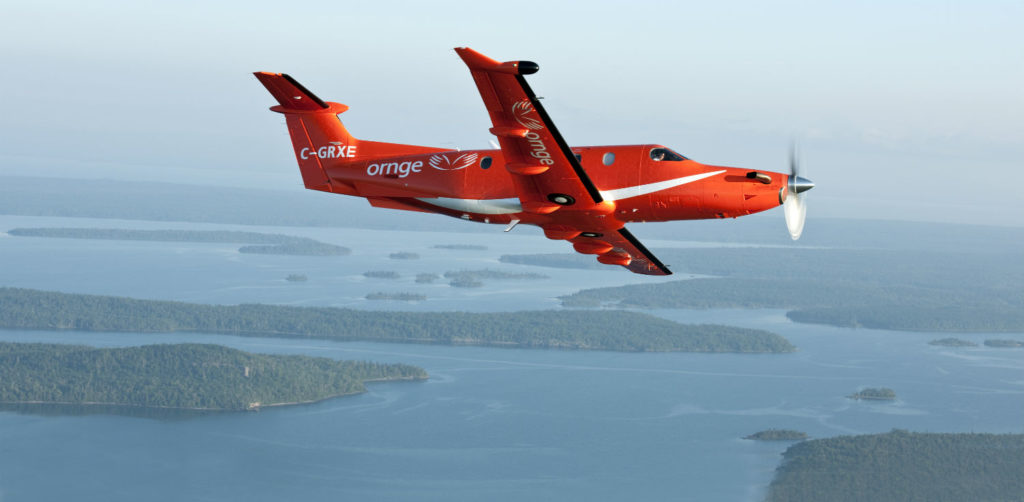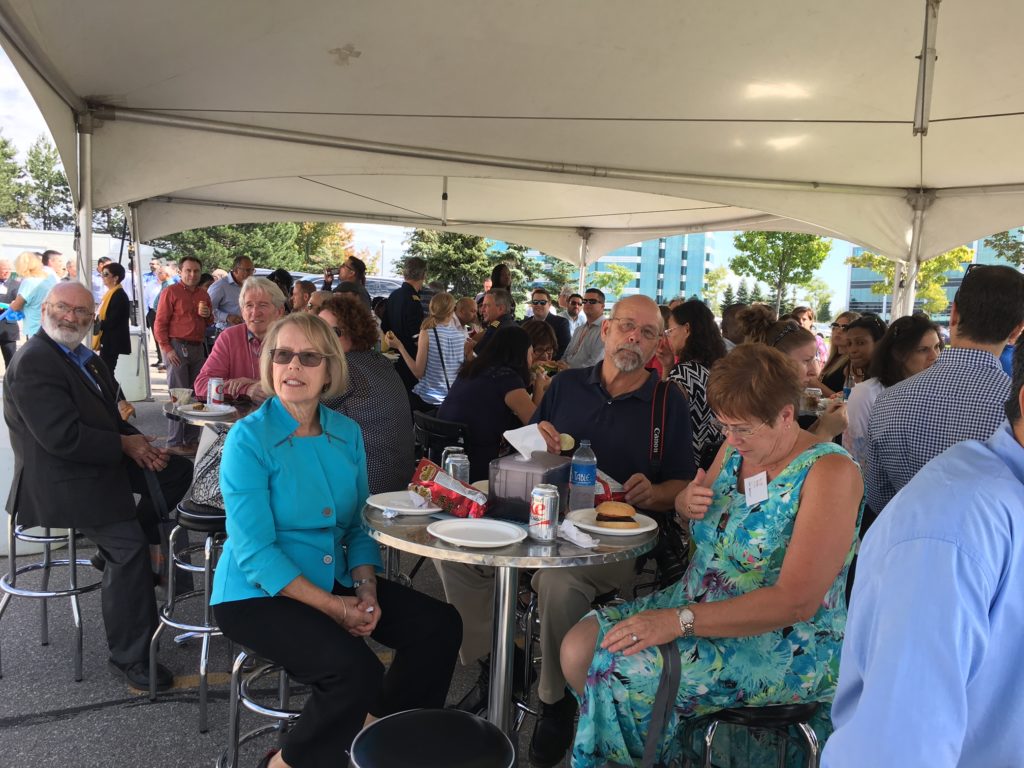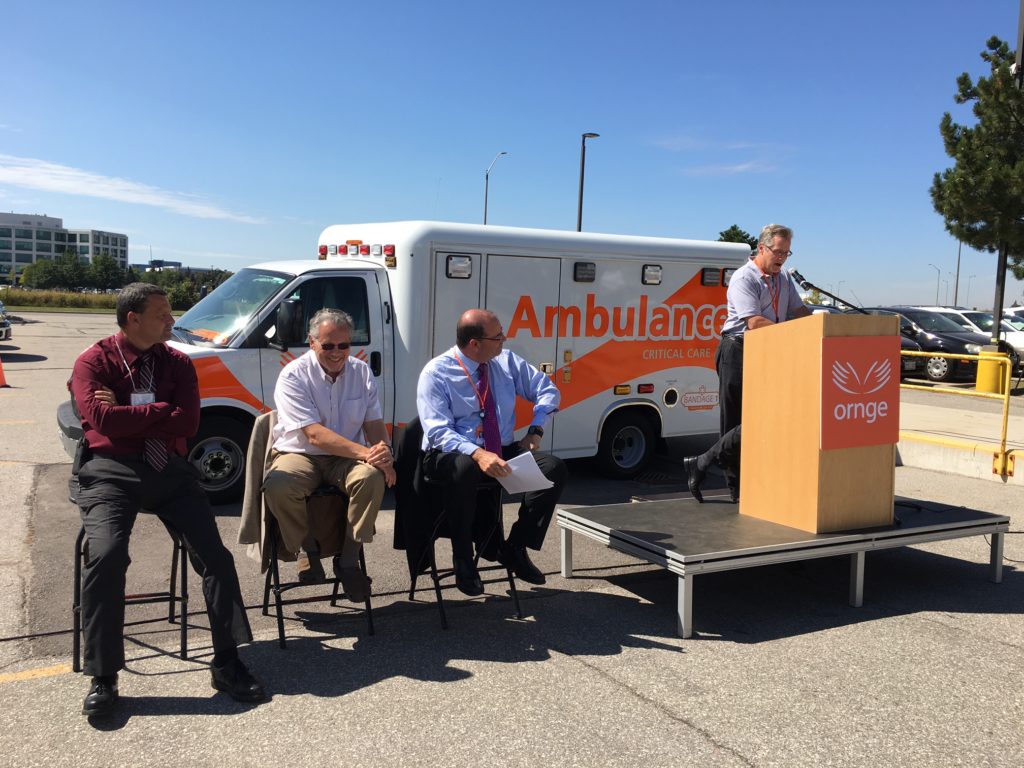Estimated reading time 9 minutes, 27 seconds.
Forty years ago in 1977, there was no such thing as emergency medicine in Ontario. There was no such thing as a paramedic and no organized air ambulance in the province.

But a handful of visionaries–influenced by the leading role helicopters played in patient transfer and critical care delivery during the Vietnam War–advocated for the creation of a dedicated, structured system that would deliver air ambulance services and related care to every citizen in the province, no matter where they lived.
Thanks to those pioneers, air ambulance in Ontario has come a long way in just four decades.

“As hard as it is to believe, all of this began as a pilot project,” said Dr. Andrew McCallum, Ornge CEO and president.
He was speaking to a large crowd of well-wishers on Sept. 13, 2017, when Ornge hosted an open house and barbecue at its headquarters in Mississauga, Ont., to celebrate the 40th anniversary of dedicated air ambulance service in Ontario.
“In early October 1977, the program began with the launch of a twin-engine Bell 212 helicopter as Ontario’s first official helicopter air ambulance at Buttonville Airport,” McCallum said from a podium in the Ornge parking lot. “The Ontario government sponsored the one-year trial, and the helicopter was operated by Viking Helicopters Ltd.

“The aircraft had all the latest medical equipment,” he continued. “All it needed was a name. Thanks to a submission from a young girl in Kitchener, named Susan Davis, the aircraft was branded as ‘Bandage 1.’ ”
The helicopter, which was associated with Sunnybrook Health Sciences Centre, was expected to carry about 500 critically ill or injured people to Toronto-area hospitals in a year. An elite team of eight paramedics and several ICU nurses was chosen for the project.
“This team was certainly up to the challenge,” said McCallum. “We started to see stories of life-saving care performed inside the helicopter. There were traffic accidents, industrial accidents, various traumatic injuries, and in one case the delivery of twins inside the air ambulance.”
Soon, the pilot project was permanent.

By 1981, four more rotary- and fixed-wing aircraft had been added to the Bandage family: No. 2 was in Sudbury; 3 in Thunder Bay; 4 in Timmins and 5 in Sioux Lookout.
“For the first time this was a genuine, dedicated provincial air medical transport system,” continued McCallum. “For me, as a resident physician in the University of Toronto Emergency Medicine Training Program in the mid-1980s, it was a privilege to work with these skilled individuals. I can tell you the system was not nearly as evolved as it is now, but the care provided was second to none.”
Today, Ornge transports more than 19,000 patients throughout the province each year, using a dedicated fleet of 11 Leonardo AW139 helicopters, eight Pilatus PC-12 NG fixed-wing aircraft, and 12 land ambulances. In addition, five standing agreements with outside air carriers allow Ornge to access the services of an additional 17 aircraft.
Special Guests
McCallum welcomed a number of special guests to the open house, including renowned orthopedic surgeon Dr. Robert McMurtry, who founded and directed Canada’s first trauma unit at Sunnybrook in the 1970s.
McMurtry was a strong and tireless advocate for Bandage 1.

He recounted the story of Sue Beatson, a resident of Sunderland, Ont., who went into premature labour with her twins in August of 1978. At just 30 weeks gestation, Beatson’s doctor called for the air ambulance to take her to Toronto’s SickKids Hospital.
“The first baby was delivered around Stouffville,” recalled McMurtry, who as the base hospital physician was in his car driving to meet them at SickKids.
While talking to the paramedics via a “clunky” radio telephone, McMurtry was stopped by police for running a red light. After some fast talking, the police actually escorted him to the hospital.
“Sue Beatson was fine, the babies were fine, and I didn’t get a ticket,” laughed McMurtry, who met Beatson at Ornge’s 40th anniversary event.
Also in attendance was Bandage 1 original paramedic Bob Fretz, who delivered both twins in the helicopter, with the second arriving moments before landing at SickKids.
Compassion and Caring
Bryan Justice, who started in 1985 as a flight paramedic on Bandage 5, a King Air 200 based in Sioux Lookout, Ont., is currently a paramedic education specialist at Ornge headquarters.
He told the crowd that aside from the sheer size of the organization today, there are many similarities to the early days of Bandage 1.
“Air ambulance has always been about clinical excellence,” said Justice. “We extend the resources from the big hospital to the small centre, wherever it is required.

“If you were a patient flying with us, you were having the worst day of your life. Your family was having the worst day of their lives. Compassion and caring underscored what we did then, and it underscores what we do now.”
Detective Constable Pete Tucker of the Ontario Provincial Police experienced Ornge’s extraordinary level of patient care firsthand.
A member of the OPP’s Golden Helmets demonstration squad, Tucker was riding with other team members southbound on Highway 400 on June 26, 2014.
Out of nowhere, he was hit by a Canada goose in flight, which knocked him unconscious and caused him to crash into the guardrail, severing his left leg above the knee.
“A whole bunch of people saved my life that day,” he said at the Ornge event on Sept. 13. “I’m here today as a result. I’m working full-time again. I owe it all to the people who saved me that day. Air Ornge is the reason I’m here today.”
Although Tucker doesn’t remember flying from Barrie to Sunnybrook, he knows he was in the best hands on the worst day of his life.
It’s this tremendous history of patient care that Ornge is celebrating four decades after Bandage 1 first took off.
McCallum said the legacy will be honoured in a more tangible way, in the form of special anniversary decals that will be applied to the fleet.
“I’m proud to announce that for the next year, we will be naming our aircraft and land vehicles in Toronto, Sudbury, Thunder Bay, Timmins and Sioux Lookout with their original Bandage designations,” he said. “Commemorative decals are being shipped to our bases as we speak.”
All other bases will receive 40th anniversary decals denoting the date that location became operational.
Ornge hopes the decals will remind staff of the service’s proud history while educating patients and the public about Ontario’s air ambulance heritage.
“Our organization is proud to be the stewards of a program that has played such an integral role in caring for the patients of Ontario. We have a tremendous legacy of patient care,” concluded McCallum.









I was one of the original 8 paramedics in 1977 and graduate of 1972 EMCA af Humber college.
Sorry I missed the 40 year anniversary. Didn’t know about it.
Do you have a paramedi alumni and magazine?
Tnank you
Jim Ewin BA, CHS
Formed Paramedic Bangage 1
I recall being on a six week contract to welcome in Bandage Three at the Thunder Bay Flying Club. I eventually worked full time at the Thunder Bay base from 1982 to 1990. It was hard starting with hospital staff in Region 6 getting used of new equipment and paramedic faces. I used to be in the army and 4 bars on the shoulder was a full colonel. So here I was working with cornels and Lt Cornels all of a sudden. But the pilots and engineers were a great bunch to work with. I and many of my fellow paramedics still have those friends today. Full time paramedics were on calls so much, we saw a great deal of part time paramedics from all over Ontario. I gave up trying to figure out the weather and just trusted the pilots. There were so many in scene calls that were incredible! Yes, what a life for those air paramedic years. Then it was onto Base Hospital and finally the College teaching at both places. Now I am retired, with memories some good and some not so good. Quite the career, but I did love being a land ambulance paramedic very much too.
I was airlifted to Sunnybrook Trauma from Barrie on Bandage 1 following a serious MVA May 1986. I was 18 at the time and wasn’t expected to make the trip but thanks to the amazing Paramedic(s) I did! I was not conscious but my family still speak highly of the way they were treated with such compassion and care while they were with me (at the time at the OPP Station).
I will always be thankful
OMG! I am a former flight nurse that worked Bandage 1 for a short period of time. I graduated in 1979 in Thunder Bay, moved on to work neonatal transport with Sick Kids Toronto. I am now retiring after 45 years from Dallas Texas. God Bless transport teams!!!!!!!